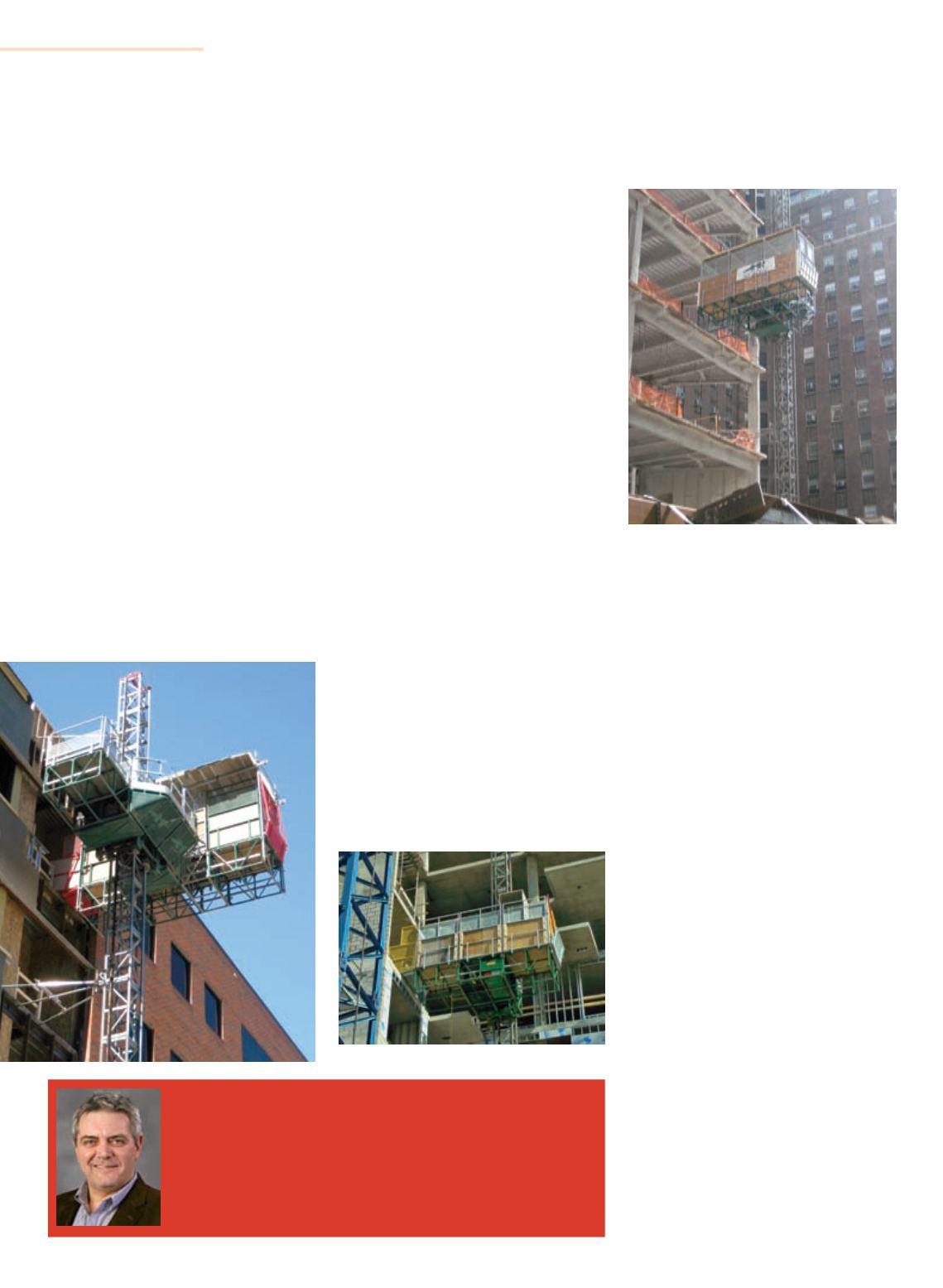
SAFETY OPINION
46
ACCESS, LIFT & HANDLERS
JULY-AUGUST 2013
THE AUTHOR:
Kevin O’Shea is the director of safety and training at Hydro-Mobile. He has
worked with Mastclimbers LLC, JLG, SGB, Lavendon and Mastclimbers LTD UK
(now Harsco). O’Shea serves as Chairman of IPAF’s North American Council,
Chairman of the SAIA’s MCWP Committee, is a member of the SAIA/OSHA
Alliance Team and has won various awards over the years, including: IPAF
Safety Champion 2009, 2010 and 2013; SAIA Council Chairperson of the Year
2009 and SAIA ‘Coupling Pin’ Award 2010.
Kevin O’Shea
, director of safety and training at Hydro-Mobile,
talks about the newest piece of kit on the mast climber block.
T
he transport platform (TP), is the newest
type of mast climbing work platform
(MCWP) on the market, and most
manufacturers of MCWPs offer a TP model.
It is quickly becoming a popular method of
getting personnel and materials to various
levels of the structure and TP use is spreading
quickly throughout North America. Many rental
companies and equipment owners can see the
advantages of the TP, but not all realize the
necessary requirements to be able to operate
or rent such a unit. The TP offers flexibility in
the rental fleet and it provides high levels of
productivity at an attractive price. But, what is
the TP? How is it different to a material hoist or
construction elevator? And what do you need to
know before you purchase or rent a TP?
There are three types of hoist generally
available:
■
Material Hoist
The material hoist is used to lift only materials
from the ground up to levels of the structure.
The transport platform –
■
Defining Features
The TP is different from the both the material
hoist and the personnel/material hoist in a
number of important ways:
Its speed is limited to 40 feet per minute. This
significantly slower speed (personnel/material
hoists can travel at hundreds of feet per minute)
is easy enough to provide excellent productivity
within its intended environment, but is slow
enough to make it easier to control, and it
therefore requires a less sophisticated operating
and drive system.
Its capacity is limited. The TP is usually
capable of lifting personnel to only 50 percent of
its capacity.
Everyone who uses a TP has to be trained
as an operator. The rationale being that in its
operating environment the unit’s frequency
of use doesn’t require a full-time operator.
Subsequently everyone who uses it has to be
trained as an operator.
The unit is setup to be further away from the
structure than the personnel/material hoist. Most
TPs are set-up about 18-inches away from the
structure and when it gets to its delivery level
integrated door/ramp arrangement is activated.
This is very different from the personnel/
material hoist which is usually set-up about
2-inches away from the structure. However
when travelling at 18-inches away there is no
chance of a shear hazard so the platform cage
arrangement doesn’t have to be so enclosed as
the personnel/material hoist does.
Most TPs can be used as ‘material only units.’
Personnel/material hoists don’t have this ability.
There are other differences between the
units, but they essentially operate in different
environments so each has been designed to
operate in its own particular way to suit its
environment.
TPs are ideal for medium-sized projects.
TPs are typically
set-up 18-inches
away from a
structure.
A Hydro-Mobile
TP at a jobsite.
Personnel are prohibited from riding in a
material hoist. It is loaded with material by the
operator at the ground level and unloaded by
workers at the delivery level above at one of
any number of floors set up to receive it. The
material hoist is covered by the ANSI standard
A10.5.
■
Construction Elevator or Personnel and
Material Hoist
The personnel and material hoist is used to
lift, as its description explains, both personnel
and materials to designated loading/unloading
points on the structure. Most of us in the
construction industry have ridden in this type of
hoist at some time. It is designed for use in high
level construction environments to deliver high
volumes of personnel and materials in a quick
efficient fashion. The personnel and material
hoist is covered by its own ANSI standard,
A10.4.
■
Transport Platform
The transport platform has elements of
both the material hoist and personnel and
material hoists. The original reason for the
existence of the TP was that in medium-sized
construction projects where the installation of
a personnel and material hoist was considered
to be unsuitable due to complexity, cost and
productivity challenges, some other safe
and productive method was required to get
personnel and materials up into the structure.
The transport platform is covered by ANSI
A92.10.


